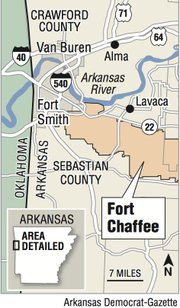A $58 million commitment from the Fort Smith Regional Healthcare Foundation and a 200-acre donation from the Fort Chaffee Redevelopment Authority will help facilitate the creation of a college of osteopathic medicine in Fort Smith, officials said Tuesday.
The $58 million four-year college could be open as early as 2017. The Arkansas Osteopathic Medical Association has lent its support to the school, which will be built to accommodate 150 students per class.
“We feel very comfortable in investing $58 million,” Fort Smith Regional Healthcare Foundation Board Chairman Kyle Parker said. “For us, though, it’s not about building a school. It’s about fulfilling our mission to serve the under-served.”
Arkansas ranks 48th in physicians per capita, according to a 2010 study by the University of Arkansas for Medical Sciences Center for Rural Health. Data from the Arkansas Department of Health point to western Arkansas as having the “greatest percentage of adults 18 and older with no personal doctor.”
In addition to meeting health-care needs, the school would generate 65 jobs with an average salary of $103,000, according to a presentation given by Parker. Additional development related to the school could help create an annual economic effect of between $75 million and $100 million.
Mercy Health System, Sparks, Cooper Clinic, the Choctaw National Health Services Authority and Community Health Centers of Arkansas have agreed in principle to provide clinical rotations and residency education to the proposed college.
Osteopathic doctors are trained to treat the entire body and focus on how the muscular, skeletal and nervous systems are connected, according to the American Osteopathic Association. More than 60 percent of osteopathic doctors are general practitioners, and the closest osteopathic medical schools to Arkansas are in Tulsa and Kansas City, Mo.
Frazier Edwards, executive director of Arkansas Osteopathic Medical Association, said the commitment from local health-care providers was a critical piece of the process. When combining support from the medical community with regional health-care needs, available land and the financial commitment from the Fort Smith Regional Healthcare Foundation, the Fort Smith proposal was an attractive one.
“We started this process and looked at all areas of the state,” Edwards said. “What we found … is that the greatest areas of need in very key demographics regarding health care rested on the western side of the state. Not only did the Fort Smith project demonstrate the need, it also demonstrated enough resources to handle the project.”
Arkansas State University also is exploring the possibility of creating an osteopathic medical school. The need for doctors is high in northeast Arkansas and the Delta, ASU System spokesman Jeff Hankins said, and ASU will continue to explore the possibility of opening its own medical school. ASU is working with the New York Institute of Technology to explore creating the medical school.
“We’re focused on working with NYIT to develop an osteopathic medical school in Jonesboro that will help provide a much-needed pipeline of primary-care physicians in the Delta,” Hankins said.
A feasibility study commissioned by ASU recommended moving forward with the school. A proposal related to an osteopathic school will be on the agenda for the Feb. 28 board of trustees meeting.
“Arkansas State welcomes collaboration with any organization addressing the physicians shortage,” Hankins said. “Our plan is to partner with a well-established D.O. school and integrate it with all of our existing research university infrastructure - from health professions curriculum and faculty to student services.”
Business, Pages 24 on 02/19/2014

